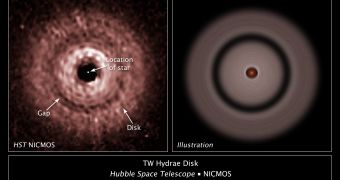The great (or frustrating) thing about working with cutting-edge science is that things can change radically from one moment to the other.
Our telescopes have pierced the universe almost as far back the Big Bang, and we have discovered hundreds of planets outside our solar system.
Yet, theories which seem solid today may be completely replaced in a few years. Case in point, astronomers have a rough idea of how planets are formed.
Either they pick up material from dust, rocks, and gas slowly as they spin around their star or, well, they do the same thing only much faster.
But a new planet possibly detected by Hubble challenges our understanding of planet formation. Looking at a relatively close-by star, TW Hydrae, which is only half as heavy as our sun, astronomers noticed a gap in its debris disk.
The gap looks to have been created by a planet circling the star and gobbling up material around it, cleaning up the debris field.
But here is where things get strange. The planet, which is only 6 to 28 times heavier than Earth (so, at most, somewhat larger than Neptune) orbits its star at a distance of 12 billion kilometers (7.5 billion miles).
That's twice the distance between Pluto and the sun. This makes TW Hydrae the most distant planet from its star ever discovered.
It gets weirder though. Because it's so far out, the planet moves slowly around its star and because of this, it should pick up material and grow slowly. A planet at that distance should take 200 times longer to form than Jupiter did.
Jupiter is estimated to have taken 10 million years to reach its size. But the TW Hydrae, the star itself, is only eight million years old, definitely not enough time for a planet to form via regular methods.
One alternative theory is that the planet formed when the debris disk became gravitationally unstable and collapsed onto itself. Through this process, a planet can be formed in thousands of years.
But this is only believed to happen for planets at least as big as Jupiter; TW Hydrae is several times smaller than Jupiter. Astronomers are hoping that future, more powerful telescopes, like the James Webb, will be able to shed more light on the matter.

 14 DAY TRIAL //
14 DAY TRIAL //